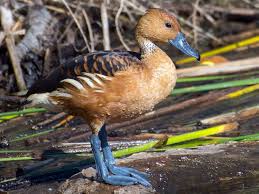
Fulvous Whistling-Duck
Dendrocygna bicolor
Order:
Family:
Size:
Weight:
Taxonomy:
Short Description:
The fulvous whistling duck or fulvous tree duck (Dendrocygna bicolor) is a species of whistling duck that breeds across the world's tropical regions in much of Mexico and South America, the West Indies, the Southern United States, sub-Saharan Africa and the Indian subcontinent. It has plumage that is mainly reddish brown, long legs and a long grey bill, and shows a distinctive white band across its black tail in flight. Like other members of its ancient lineage, it has a whistling call which is given in flight or on the ground. Its preferred habitat consists of wetlands with plentiful vegetation, including shallow lakes and paddy fields. The nest, built from plant material and unlined, is placed among dense vegetation or in a tree hole. The typical clutch is around ten whitish eggs. The breeding adults, which pair for life, take turns to incubate, and the eggs hatch in 24–29 days. The downy grey ducklings leave the nest within a day or so of hatching, but the parents continue to protect them until they fledge around nine weeks later. The fulvous whistling duck is 45–53 cm (18–21 in) long; the male weighs 748–1,050 g (26.4–37.0 oz), and the female averages marginally lighter at 712–1,000 g (25.1–35.3 oz). It is a long-legged duck, mainly golden-brown with a darker back and an obvious blackish line down the back of its neck. It has whitish stripes on its flanks, a long grey bill and grey legs. In flight, the wings are brown above and black below, with no white markings, and a white crescent on the rump contrasts with the black tail. All plumages are fairly similar, but the female is slightly smaller and duller-plumaged than the male. The juvenile has paler underparts, and appears generally duller, especially on the flanks. There is a complete wing moult after breeding, and birds then seek the cover of dense wetland vegetation while they are flightless. Body feathers may be moulted throughout the year; each feather is replaced only once annually. The fulvous whistling duck feeds in wetlands by day or night on seeds and other parts of plants. It is sometimes regarded as a pest of rice cultivation and is also shot for food in parts of its range. Despite hunting, poisoning by pesticides and natural predation by mammals, birds and reptiles, the large numbers and a huge range of this duck mean that it is classified as least concern by the International Union for Conservation of Nature. In Pakistan considered as Vagrant, prefers Freshwater wetlands. A Scattering of records, but only one in recent decades near Lal Suhanra, Bahawalpur.
Far far away, behind the word mountains, far from the countries Vokalia and Consonantia, there live the blind texts. Separated they live in Bookmarksgrove right at the coast
Bahawalpur,Kasur,Thatta,Karachi South
Far far away, behind the word mountains, far from the countries Vokalia and Consonantia, there live the blind texts. Separated they live in Bookmarksgrove right at the coast
About Photographer : Hello World
Facebook
Twitter
Instagram
Flicker
LinkedIn

